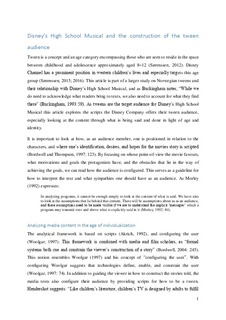| dc.contributor.author | Sørenssen, Ingvild Kvale | |
| dc.date.accessioned | 2019-05-07T09:41:18Z | |
| dc.date.available | 2019-05-07T09:41:18Z | |
| dc.date.created | 2018-08-27T14:19:07Z | |
| dc.date.issued | 2018 | |
| dc.identifier.citation | Global Studies of Childhood. 2018, 8 (3), 213-244. | nb_NO |
| dc.identifier.issn | 2043-6106 | |
| dc.identifier.uri | http://hdl.handle.net/11250/2596755 | |
| dc.description.abstract | This article explores how the Disney Company scripts what it is to be a tween through the High School Musical trilogy. While children’s perspective is of pivotal concern within childhood studies, it has traditionally left out the material aspects and rather focused too narrowly on the subject and the social. I found that the trilogy was watched several times by tweens, thus in addition to exploring children’s voices and perspectives on media content, we also need to examine what the audience is served. The High School Musical trilogy is about teenagers as they attend high school, while it is the younger age group, tweens, who are the main target audience. Implicitly, this tells us that the Disney text configures its audience as aspiring teenagers. The article sets out to explore how Disney configures its tween audience by looking at how identity and age are scripted in the trilogy. Through the lens of the individualization thesis drawing on Beck and Beck-Gernsheim the article analyzes how age, identity, and individuality is portrayed in the trilogy. The article finds that the paradox of becoming a unique individual on one hand, and social obligations on the other hand, are present in the trilogy subsequently abiding in an ambiguous configuration of tweens through the High School Musical trilogy. | nb_NO |
| dc.language.iso | eng | nb_NO |
| dc.publisher | Sage Publications | nb_NO |
| dc.relation.uri | http://journals.sagepub.com/doi/pdf/10.1177/2043610618796722 | |
| dc.title | Disney’s High School Musical and the construction of the tween audience | nb_NO |
| dc.type | Journal article | nb_NO |
| dc.type | Peer reviewed | nb_NO |
| dc.description.version | acceptedVersion | nb_NO |
| dc.source.pagenumber | 213-244 | nb_NO |
| dc.source.volume | 8 | nb_NO |
| dc.source.journal | Global Studies of Childhood | nb_NO |
| dc.source.issue | 3 | nb_NO |
| dc.identifier.doi | 10.1177/2043610618796722 | |
| dc.identifier.cristin | 1604718 | |
| dc.description.localcode | © 2018. This is the authors' accepted and refereed manuscript to the article. The final authenticated version is available online at: https://doi.org/10.1177/2043610618796722 | nb_NO |
| cristin.unitcode | 194,67,70,0 | |
| cristin.unitname | Institutt for pedagogikk og livslang læring | |
| cristin.ispublished | true | |
| cristin.fulltext | original | |
| cristin.qualitycode | 1 | |
